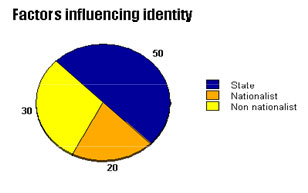Suggested Activities
Students explore the influence of nationalist loyalties on personal identity by assessing the significance of state, national and non-national affiliations in defining their personal identities and those of their classmates.
Explore sources of personal pride
Provide students with a list of events and invite them to identify which events make them feel the greatest pride. Events to consider include the following:
- someone in their school is drafted by an NHL team
- a Canadian wins an Olympic gold medal
- an Albertan wins an Olympic gold medal
- a Ukrainian-Canadian wins an Olympic gold medal
- Italy wins the World Cup in soccer
- Aboriginal musicians are honoured with international awards
- someone in their community receives a national award
- the French language is judged to be one of the most romantic and expressive languages
- a Haitian-born refugee is appointed Governor General.
Encourage students to suggest other personal, local, national and international events that are sources of personal pride. Record all the suggested events on the board. To meet diverse learning needs, consider reducing the number of events.
Prioritize the sources of pride
Invite students, individually, to identify the 10 events from the above list that are personally most significant. Ask students to consider events that provide them with the greatest attachment or allegiance or the greatest sense of pride. Direct students to record each of the 10 events on a cue card or sticky notes and to arrange them in order in a top 10 list. Next, organize students in groups to discuss which of the suggested events have the most significance for the group as a whole. If there is no consensus in the group on the 10 most significant events, encourage subgroups to assemble separate lists.
Consider other views
Once the groups have identified their top 10 lists, encourage them to examine the most significant events that other groups have identified. Invite students to discuss the differences among the groups.
Introduce the concepts of nation and state
Introduce students to the distinction between nation and state. Begin by sharing various definitions of nation and invite students to identify the factors that characterize a group of people as a nation (see References). Point out the ambiguous use of nation to include what is more technically understood to be a state:
- nation: a group of people with a common origin and shared language, culture and customs; e.g., Cree, Scots
- state: a sovereign area in the world, often synonymous with country; e.g., Canada, Republic of Ireland.
Introduce the concepts of nation-state and a multination state
To help students see the relationship between these two terms, introduce the distinction between a nation-state and a multination state:
- nation-state: when a particular sovereign geographic area is occupied by one nation (strictly speaking this no longer exists, but Iceland and Japan are thought by many to approximate a nation state)
- multination state: when a particular sovereign geographic area is occupied by more than one nation; e.g., Canada, United Kingdom.
Classify the events
Direct students' attention to their top 10 events. Ask them to sort these events into three categories:
- national focus—based on common heritage, language or customs within a group
- state focus—based on geographic or civic affiliation
- non-national focus—based on local connections, personal preferences.
Assess the relative importance
Invite students to rate the categories by considering two criteria:
- the number of events in each category
- the significance that the events have for the individual in terms of personal allegiance or sense of pride.
Ask students to assign an overall percentage of influence to each of the three categories of events (the total should be 100%). For example, students might decide that nationalist events represent approximately one-half (50%) of their mix of significant affiliations and the other two categories of events contribute equally (25% each).
To help determine a percentage allocation, encourage students to use one of the charts in Rating Options (Support Material) to assess the impact of each top 10 event and tally the score for the three categories.
Prepare a visual representation
Encourage students to prepare a visual representation of the relative significance of each of the three sources of their personal identity. Students might construct a pie chart illustrating the percentage allocation and prepare written responses to explain the reasons for their allocation. The following chart was prepared electronically using a program available from the National Centre for Educational Statistics (see References). To meet diverse learning needs, consider forgoing the written responses and have students provide an oral justification of their allocations.

Discuss the findings
Arrange for students to share their visual representations and explanations. Lead a discussion about the relationship between identity and national and state affiliations by posing the following questions:
- Why do you think your identity mix has the focus that it does (e.g., Why might it be so heavily state-focused or nation-focused?)
- What differences do you notice in your identity mix and those of others in the class? What factors might explain these differences?
- What are the advantages and disadvantages of various emphases (e.g., What are the benefits and shortcomings of a population with a heavily state-focused identity?). Consider the advantages and disadvantages from the perspective of an ordinary citizen and as a leader of a country.
|








